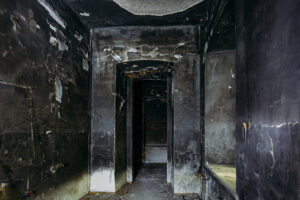How To Remove Soot From Different Sources
 Fires have a host of devastating effects on the homes they hit. One of the most underappreciated of these effects is soot. Soot is composed of microscopic, toxic materials left behind from the fire. Inhaling soot can have devastating health consequences. It is also extremely difficult to remove from the materials it penetrates. In fact, removing soot from materials like wood, carpet, and curtains is sometimes the most challenging aspect of the fire damage restoration process.
Fires have a host of devastating effects on the homes they hit. One of the most underappreciated of these effects is soot. Soot is composed of microscopic, toxic materials left behind from the fire. Inhaling soot can have devastating health consequences. It is also extremely difficult to remove from the materials it penetrates. In fact, removing soot from materials like wood, carpet, and curtains is sometimes the most challenging aspect of the fire damage restoration process.
Fire Damage Roswell
Here are our tips at Restoration 1 of North Atlanta on how soot can be removed from these different materials after a flood.
Metal
To get started removing soot from metal, take your metal object outside and use the hose to spray it down until all of the soot residues comes off. If there are still stubborn marks left over, scrub off any remaining marks from your metal items. When finished, rinse with water again and dry completely before bringing it back inside to prevent rusting.
Wood
An oven cleaner or Windex with ammonia and water typically works well for removing soot stains from wood. Apply the cleaning solution liberally and then wipe with a damp cloth. This will clean up the soot stain in most cases. As an important note, you should NOT use vinegar for dealing with soot stains in wood. While vinegar is a commonly used cleaning solution, it can leave stains and permanently damage wood surfaces.
Concrete
Acid or alkaline cleaners are well-suited to cleaning soot stains in concrete. Apply the cleaner liberally to the affected area, scrub, and rinse to remove the soot. There may still be visible soot stains left over, however. To deal with these, you can use a pressure washer. You do not want to use the pressure washer at the outset, though, since this can cause the soot (which is very scratchy) to damage the concrete.
Carpet
Removing soot stains from the carpet may seem intimidating, but it’s not impossible. Start by vacuuming up the soot on a low setting and then using a wet-dry vac to suck it back up. Baking soda or cornstarch may also help absorb some of the grease and oil and make it easier to clean up the mess. More intense cleaning solutions like benzyl acetate or a solvent may be necessary if the mess is particularly stubborn.
Curtains
Begin by vigorously shaking out the curtains and applying both baking soda and a stain remover. Next, rinse out the fabric, give it an additional soak in baking soda and vinegar, and then rinse out the soot.
As you can see, cleaning up soot damage is no easy task. A different approach is required for cleaning soot off of different materials as well. Fortunately, our fire damage restoration technicians at Restoration 1 of North Atlanta are experienced in dealing with all types of soot removal from various sources. Give us a call today if your home has been damaged by a fire.
